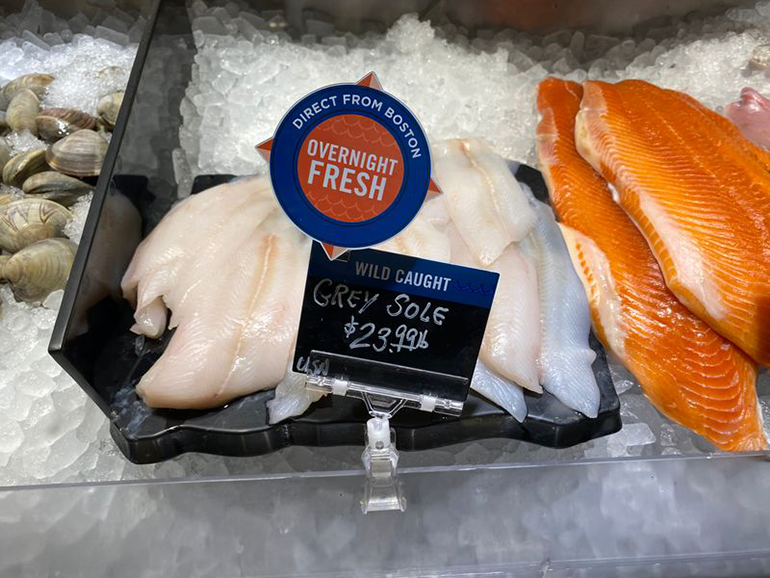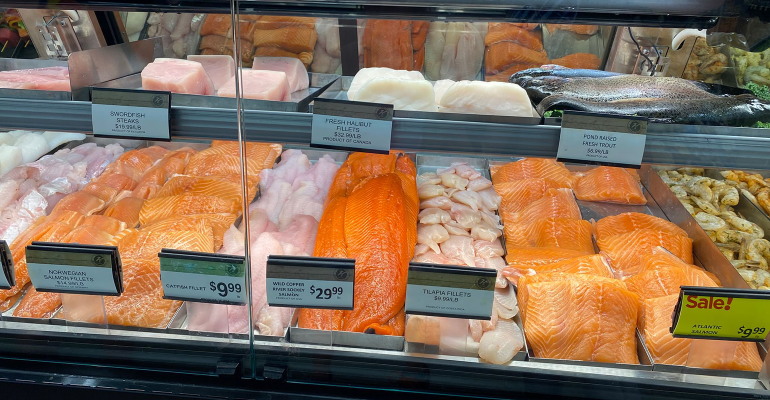Getting more shoppers to put seafood on the front burner when considering meal solutions remains an arduous task for merchandisers.
Despite its well-publicized health benefits, many consumers are eschewing the protein and state that seafood is “not top of mind” when food shopping.
“The proportion of Americans who are non-seafood consumers has grown in the past year to now being almost one-half of all Americans,” states the Power of Seafood 2023 report, published by Arlington, Va.-based FMI — The Food Industry Association. “The perceived high cost of seafood has driven consumers from being seafood consumers to being non-seafood consumers.”
Top factors cited by shoppers in an FMI survey on why they do not eat seafood include cost/expense, which was named by 48% of respondents; cost compared to other proteins (39%); preference for other food (36%); and taste or flavor (31%).

Emphasizing the freshness of refrigerated seafood is a powerful selling point.
“Seafood has an uphill climb in the U.S. because of its cultural tradition and geography,” said Jim Wisner, president of Wisner Marketing LLC, a Gurnee, Ill.-based retail consultancy. Because many Americans do not live in coastal areas, where there often is a greater availability and emphasis on fresh seafood, it is difficult creating a national seafood-eating consciousness, he said.
More potential buyers also are avoiding seafood because of negative publicity of such issues as the impact that fishing is having on the oceans and the possible ingestion of microplastics when eating fish, he said.
In addition, consumers worry that they risk spoilage if they do not eat fresh seafood quickly after purchase or that they will prepare it incorrectly, Wisner said.
Because of the greater shopper interest in meat and poultry, some retailers treat seafood as “little more than a niche department” and do not stage promotions that can drive greater awareness and buying, Wisner said. “Seafood is not as ubiquitous as fresh meat and other protein options,” he said.
Merchandisers, however, can make seafood more appealing by comparing the health benefits to that of red meat, Wisner said. “Almost any consumer will agree that fish is better for you and is low in calories with less saturated fat,” he said. “That is a very strong message.”
Even shrimp, which remains the most popular seafood option, can benefit from greater merchandising, Wisner said, which can include offering a wider range of varieties, such as cooked, uncooked, peeled, and deveined.
Educating consumers on the benefits of frozen seafood, such as its longer shelf life, and the tastes of the different varieties can spark interest as well, he said. “Frozen seafood is typically going to be fresher than the fish in the fresh case, particularly if it is frozen on the boat,” Wisner said. “But most retailers do not promote it very well and shoppers won’t buy an item if they don’t know what it is.”
Retailers, he said, should “romance” seafood by highlighting the appealing attributes of unfamiliar selections while also offering a greater number of species.
“Frozen cases often contain four varieties or fewer without any product information,” Wisner said. “It is not as interesting as it can be.”
Seafood departments with limited case space can offer additional selections by rotating species seasonally, he said, adding that because seafood pricing often varies by season in accordance with inventory, retailers should promote selections “aggressively” when the costs are less.
Ensuring seafood stays fresher longer can be a focus as well, Wisner said, noting that retailers should leverage supply chains that enable stores to receive seafood shortly after capture. “They need to maximize customer satisfaction and not have shoppers inquire why the fish does not taste good,” he said.
To help attract more eco-conscious shoppers, retailers must better explain their standards for supporting sustainable fishing, including where and how products were sourced “and not just have the information buried deep on their websites,” he said.
Operators can further enhance shopper interest by situating racks with information sheets and recipe cards on the full-service counters, while also cross-merchandising seafood with other recipe components, such as sauces and spices, Wisner said.
In addition, there are growth possibilities from marketing seafood as an attractive option for different eating occasions. While 56% of retail seafood revenues currently derive from consumers purchasing the protein for dinner, there are opportunities to increase seafood consumption for lunch, which accounts for 33% of earnings, as well as breakfast (4%) and between meals (7%), reports Circana, a Chicago-based market research firm.
Value-added, which accounts for 26% of refrigerated seafood sales, has expansion potential as well, Circana states. Retailers currently are merchandising an average of 21 value-added seafood items per store, Circana notes.





